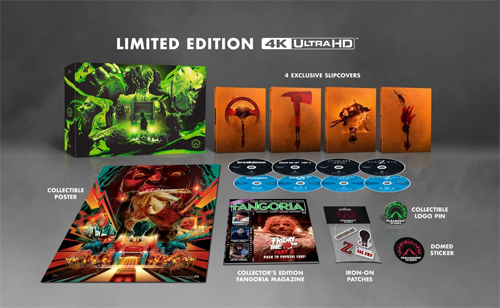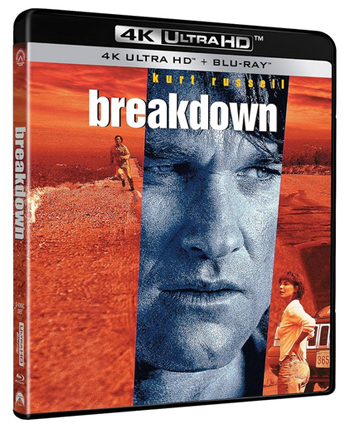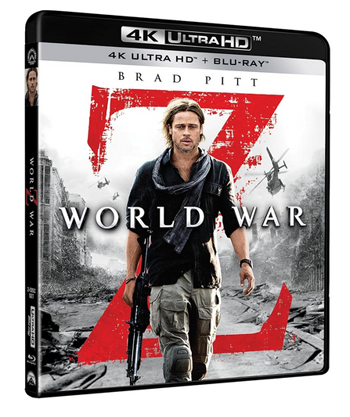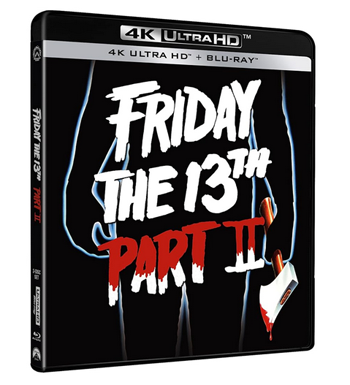
By Todd Garbarini
Paramount Scares Volume 2 4K UHD is a
new box set from Paramount that contains four thrillers, coming on the heels of
last year’s release of Volume One. One of the titles is brilliant, one of them is
damn good, one of them is so-so, and one of them is…well, meh…
Breakdown (1997)
Kurt Russell and the late great character
actor J.T. Walsh have shared the screen multiples times together, specifically
in Robert Towne’s Tequila Sunrise (1989), Ron Howard’s Backdraft
(1991), and Stuart Baird’s Executive Decision (1994). In Jonathan
Mostow’s Breakdown, they have formed their final and most gripping
pairing to date.
Breakdown is a real surprise and a masterpiece of tension. To
disclose the plot would destroy what I found to be an utterly nail-biting
motion picture experience, which is something I do not think I have ever truly
experienced. There are some spoilers ahead, so non-viewers please tread
lightly. There is such an overwhelming sense of menace and peril in Breakdown
that it almost becomes a cruel experiment in fear. For a first-time directing
job by Mr. Mostow, who previously scripted the Michael Douglas/David Fincher
film The Game (1997), Breakdown is awe-inspiring. The opening
credits sequence alone is imaginative and appropriate to the story, utilizing
animation to simultaneously represent a mesh of cartographic interstates and
what could also be construed as cerebral arteries. The film’s title is a double
meaning. Kurt Russell and Kathleen Quinlan are Jeff and Amy Taylor, a
forty-something married couple moving from New England to San Diego, California
in a brand-new Jeep Grand Cherokee Laredo SUV. On their way driving through the
empty plains of the Midwest, Jeff is momentarily distracted reaching for his
thermos and just misses crashing into a mud caked Ford F150 pick-up driven by a
large man who shouts obscenities. An unfortunate encounter ensues later when
the man castigates Jeff while refueling. Speeding away, the new Jeep suffers an
electrical difficulty and Jeff and Amy find themselves stranded in a place
befitting of an Alfred Hitchcock thriller. The Ford truck speeds by, cheerfully
acknowledging the couple’s plight with a long horn blow leading to a brief and
tense stand-off which is alleviated by the arrival of Red Barr, a truck driver
(the late great J.T. Walsh) who offers to give Amy a ride to Belle’s Diner some
miles down the road to call road service (his CB blew a fuse earlier and is
non-functioning). When she accepts, Jeff waits…and waits…and discovers an
unplugged wire in the Jeep’s undercarriage.
Normally, I would call out Amy’s foolishness
for accepting such a ride as a woman her age should know the dangers of
hitch-hiking, however New Englanders routinely give rides to one another, and
this plot point helps explain her action. Jeff makes his way to the diner and
all the patrons and owner (a terrific turn by character actor Jack McGee) do
not recall seeing her, except for a mildly slow co-worker in the parking lot.
This puts into motion a high level of suspense as Jeff’s cell phone fails to
get decent service while he rushes to find his wife. It turns out that Jeff and
Amy have been pegged for financial embezzlement by Red, Earl (M.C. Gainey as
the Ford driver), Billy (Jack Noseworthy, the “slow” diner worker), and Al (the
late Rich Brinkley), a husky accomplice. Rex Linn of TV’s Better Call Saul
is also on hand as a police officer who offers Jeff some recourse.
Breakdown, which opened on Friday, May 2, 1997, might appear to be
an action film, but it is more of a thriller with some action sequences. It has
been a longtime indeed since this level of suspense has seen the light of day
on the silver screen. It is so good, in fact, that it feels like a Seventies
film made in the Nineties. It is amazing that it was not the blockbuster that
it deserved to be. Poor marketing perhaps?
Shooting in the 2.35:1 Panavision ratio, Mr.
Mostow has created a plausible scenario replete with four of the most
frightening villains seen of late. They certainly give Bill McKinney and
Herbert "Cowboy" Coward, the mountain men in Deliverance
(1972), a run for their money. J. T. Walsh, who unfortunately passed away not
too long after this film was released (his death is a real loss to the film
world), appears in one of the best performances of his sterling and memorable
career: a purely evil man who doubles as an everyday Joe who loves his wife and
son (Moira Harris and Vincent Berry, respectively) but commits terrible acts
for money. You get the feeling that these monsters have been doing what they do
for a long time, although there were moments wherein I thought a double-cross
would transpire among them. They all appear to be loyal to one another, making
me wonder how these guys ended up together in the first place. The supporting
cast all do a phenomenal job as well.

Breakdown’s plot is by no means original. This type of story
depicting a person who goes missing has been told over many decades: Robert
Fuest's And Soon the Darkness (1970), Philip Leacock's television film Dying
Room Only (1973), and, in particular, George Sluizer’s icy 1988
Dutch/French character study Spoorloos, known in the States as The
Vanishing. Breakdown succeeds for the same reason that Steven
Spielberg's Duel (1971) does (though Duel is more cinematic): it
takes two ordinary human beings and thrusts them into a horrendous situation
they would never have any reason to suspect they would ever be a part of. That
is not to say that the film does not have a few convenient plot devices, but
even when it does, they can be forgiven.
Kurt Russell is perfectly cast. I loved him
as Snake Plissken in John Carpenter’s Escape From New York (1981) and as
MacReady in John Carpenter’s The Thing (1982). He is an amazing and
criminally underrated actor. The look of terror and fear on his face is
complete and real. Some reviews have criticized the film’s ending, but for me
it is a much needed and deserving money shot and a relief; it makes me wonder
the future of the people sitting in the final frame.
Supplements:
A feature-length audio commentary with the
director and Kurt Russell. If you have ever heard any of the previous
commentaries that Mr. Russell has been involved with, specifically with
director John Carpenter on Escape from New York (1981) and The Thing
(1982), you know that he is one of the most entertaining people to listen to.
He also has a phenomenal laugh and chuckles through most of the film, even
making fun of Jeffrey! Hilarious. They speak about Dino DeLaurentiis; having
gotten cinematographer Doug Milsom who worked on four films with Stanley
Kubrick; Mr. Russell imitating Dennis Weaver in Duel (“You can’t catch
me on the grade!”); the director discussing how he wrote a role for Morgan
Freeman as a character whose wife was kidnapped and teams up with Jeffrey, the
idea later wisely written out of the script; Roger Ebert criticized the bank
scene, but the commentary states that they were rushed to get it done on the
location but I think it works just fine. Overall, a truly fun and entertaining
listen and easily the best extra.
Filmmaker Focus - Jonathan Mostow
(10:45) – This piece is a spotlight on the director that highlights much of
what was said during the commentary.
Victory is Hers: Kathleen Quinlan on
Breakdown (4:22) – I was so happy to see Kathleen Quinlan included
in this edition and she discusses some of her experiences making the film.
A Brilliant Partnership: Martha De Laurentiis
on Breakdown (8:18) – This is a piece dedicated to one of
the producers of the film. Mrs. De Laurentiis worked with her late husband,
Dino, on the film and this is a look at their partnership.
This collection contains both a Blu-ray and a
4K UHD disc of this film and they both look stunning on both formats, light
years ahead of the VHS, laserdisc, and DVD transfers of just over 25 years ago.

World War Z (2013)
Brad Pitt tends to be more well-known for his
familial troubles than for his acting, which is a shame because he truly is a
terrific actor. Mr. Pitt shines in Marc Forster’s 2013 outing World War Z,
a film which had its origins in 2006 by way of the novel World War Z: An
Oral History of the Zombie War, authored by Max Brooks, which is a
follow-up to the author’s 2003 novel The Zombie Survival Guide. The film
feels inspired by the late George A. Romero’s zombie films, and Danny Boyle’s 28
Weeks Later (2002), and clearly influenced Yeon Sang-ho’s excellent Train
to Busan (2016). The zombies in this film move at a frightening and
alarmingly high rate of speed, their attention drawn to new hosts by their
impeccable hearing – the slightest noise send them into a flesh-eating rage. Mireille Enos, so good in the cable series
“The Killing,” here is deeply affecting as Mr. Pitt’s wife. The film opens with
near maddening ferocity, however the ending is far quieter and more subdued. It
is a longer film than most, however it is well worth watching. The CGI effects,
while fairly obvious, are actually quite good.
Paramount has included the PG-13 version of
the film on 4K UHD, and the unrated version (which I prefer) on the standard
Blu-ray. The transfers are good, but nothing earth shattering.
Supplements:
Origins – this is in high
definition and runs 8:21. Producer Jeremy Kleiner, producer Dede Gardner,
director Marc Forster, actress Mireille Enos, and writer J. Michael Straczynski
weigh in on the making of this apocalyptic tale which also differentiates
itself by playing as a detective story and how to stop the contagion. In years
to come, people will be looking at films of this ilk in the context of COVID-19
and the worldwide response.
Looking to Science –
this is in high definition and runs 7:28. Producer Dede Gardner, producer
Jeremy Kleiner, author Otto Penzler, writer J. Michael Straczynski,
evolutionary biologist David Hughes, visual effects supervisor Scott Farrar, and
science writer Carl Zimmer discuss the nature of zombies and how the whole
notion of coming back from the dead originated (the fear of dying).
The piece entitled WWZ: Production is
in high definition and runs 36:18, and is broken down into small pieces: Outbreak,
The Journey Begins, Behind the Wall and Camouflage and is an
interesting look at most of the film’s aspects of production.

Orphan First Kill
(2022)
Jaume Collet-Serra’s Orphan (2009) is
a genuinely creepy film with a sterling performance by then-twelve-year-old
actress Isabelle Fuhrman in the role of Esther, a nine-year-old Russian girl
who is in actuality much, much older and suffers from hypopituitarism, a rare
disorder that has resulted in her physical growth being arrested and causing
her to not only to be short but look much younger than she is. In this prequel,
directed by William Brent Bell, we see the back story of how Esther came to be,
and the results are a tad underwhelming. In January 2007, Leena Klammer
(Isabelle Fuhrman), an adult woman whose condition makes her look 30 years
younger, is a psychiatric patient in Estonia at the Saarne Institute who
manages to seduce and murder a guard and escape by taking refuge in an art therapist’s
(Gwendolyn Collins) car. After sneaking into the therapist’s house and killing
her, Leena researches missing girls in America and notices one, Esther
Albright, who has been missing for four years. Esther’s family, who live in
Darien, Connecticut, is rich, and Leena sets her sights on impersonating
Esther. Esther’s father Allen (Rosif Sutherland of the world-renowned acting
family), her mother Tricia (Julia Stiles), and brother Gunnar (Matthew Finlan) are
reunited with Esther (the imposter Leena) and the family is seemingly made
whole again – that is, until Esther sees Allen’s kindness and begins to fall
for him. The notion that a separation of four years from a child would be
enough to pull the wool over the eyes of a family is asking a bit much from the
audience, though if you do not think too much about it, you can stomach the
somewhat predictable fallout that transpires in the form of Esther trying to
her best to kill off everyone who dares to get in the way of her love for
Allen. There is a good bit of violence to warrant the film’s R-rating and Julia
Stiles provides a surprisingly maniacal performance as a woman scorned bent on
killing the imposter at any cost. Of course, anyone who has seen the first film
knows that the family is doomed from the outset. That being said, the film is
passable, though does not break any new ground.
There are no special features on this film,
which is rather surprising given that it is part of a series of film that could
very well have more life in it.
The video quality of both the Blu-ray and the
4K UHD are very good, though the latter is probably more noticeable on a very
large television/monitor. Still, the enhanced picture quality does not a better
movie make.

Friday the 13th Part 2 (1981)
Horror film fans tend to have very memorable
impressions of when they saw a thriller that impacted them strongly. On
Friday, May 9, 1980, I watched a rerun of the John Guillermin 1976
version of King Kong on
NBC-TV and eagerly discussed it the following day with my Boy Scout troop on
our way into New York City to visit the United Nations building. Walking
through the New York streets was quite an education in many ways, not the least
of which was our journey through the theater district along 42nd Street. On the
way, we saw movie marquee displays for pornographic movies (yikes!!) and
comedies (Don Adams’s The
Nude Bomb). Friday
the 13th had just been released the previous day, and a
theater displayed lobby cards depicting images from the film. One of them
contained a mock-up of a woman screaming at a man who had been impaled on a
wall with arrows. This was the first time I had seen such a graphic image, and
it made me wonder what the rest of the movie was like. I recall being truly
disturbed by it. It would be another seven years before I would see Friday the 13th on
a local television station airing and I must admit that I found the film to be
mediocre at best. John Carpenter's Halloween (1978),
which I would see on the titular holiday in 1982, would be more my cup of tea.
I found that film
to be truly gripping and tense. Years later I caught up with the DVD release
of Friday the 13th
and my reaction was still the same. There is little doubt that had I seen the
film when I was considerably younger it would have terrified me.
Friday the 13th Part 2
(1981), which opened on Friday, May 1, 1981, the same day that La Cage aux
Folles II opened, is proof that sequel mania was unfolding. It is the
inevitable title of the inevitable sequel to the first film and, what may have
been groundbreaking and frightening back then, appears derivative, predictable,
clichéd and tired in 2024. I do not begrudge fans of the series by any means; I
just wish that I was one of them. I truly want to like the Friday the 13th
series because it is so well-known and loved by so many horror fans. Unlike Halloween
and the Michael Myers mystique, I find the characters uninteresting, the
writing uninspired, and the perpetual glances at my watch all to be an
indication of the wish for something better. The film also commits the usual
sequel faux-pas – beginning with clips from the original film (granted, Psycho
II (1983) started with a retread of the infamous show scene from the
original, but it worked). While I can somewhat forgive this decision as it may
have been done to remind the audience of what previously transpired (watching
movies more than once back then was still a new idea) and to educate those
unfamiliar with the first film, it still bothers me. Brian Gibson’s Poltergeist
II: The Other Side (1986) repeated footage from the classic original, so
this is by no means a device confined to the Friday the 13th
franchise. Jason Voorhees (portrayed by Steve Dash, handed the mantle – and the
axe – by Ari Lehman) returns as the killer who seems to know where everyone is
at any given time.
The story and camerawork are schematic, and
the “shock” ending from the first film repeats itself when without giving a
hint as to how Jason can be right where he needs to be at any given moment.
Special Features:
Inside “Crystal Lake Memories” –
this runs 11:15. Author Peter Bracke discusses his book Crystal Lake
Memories: The Complete History of Friday The 13th (2006), in
addition to how the film series got started, and a discussion regarding scenes
that ended up on the cutting room floor.
Friday’s Legacy: Horror Conventions –
this piece runs 6:50. The folks who run the ScareFest convention and some cast
members of Friday the 13th express their feelings about being at these
conventions.
Lost Tales From Camp Blood – Part II –
this runs 8:54 and is the second installment of a series of shorts made by
fans. Similar to the film it is saluting, it features a young couple in the
woods, with the woman being killed by a man who just happens to be right where
she is when she goes to pee.
Jason Forever –
this runs just shy of 30 minutes and is a video shot in 2004 at a Fangoria
convention featuring four actors who have played Jason Voorhees. The discussion
is emceed by moderated by Peter Bracke.
Original Theatrical Trailer – this is in
standard definition and runs 2:12.
There are some very neat additional extras in
the box set, among them:
Exclusive Fangoria magazine that covers all
four films.
Four exclusive slipcovers for each film with
really nice artwork to represent each film.
Exclusive Paramount Scares pin.
Exclusive Paramount Scares sticker.
Exclusive Paramount Scares poster.
Exclusive Paramount Scares patches –
these are my favorite, especially the one for Breakdown which is a
license plate!
Click here to order from Amazon
